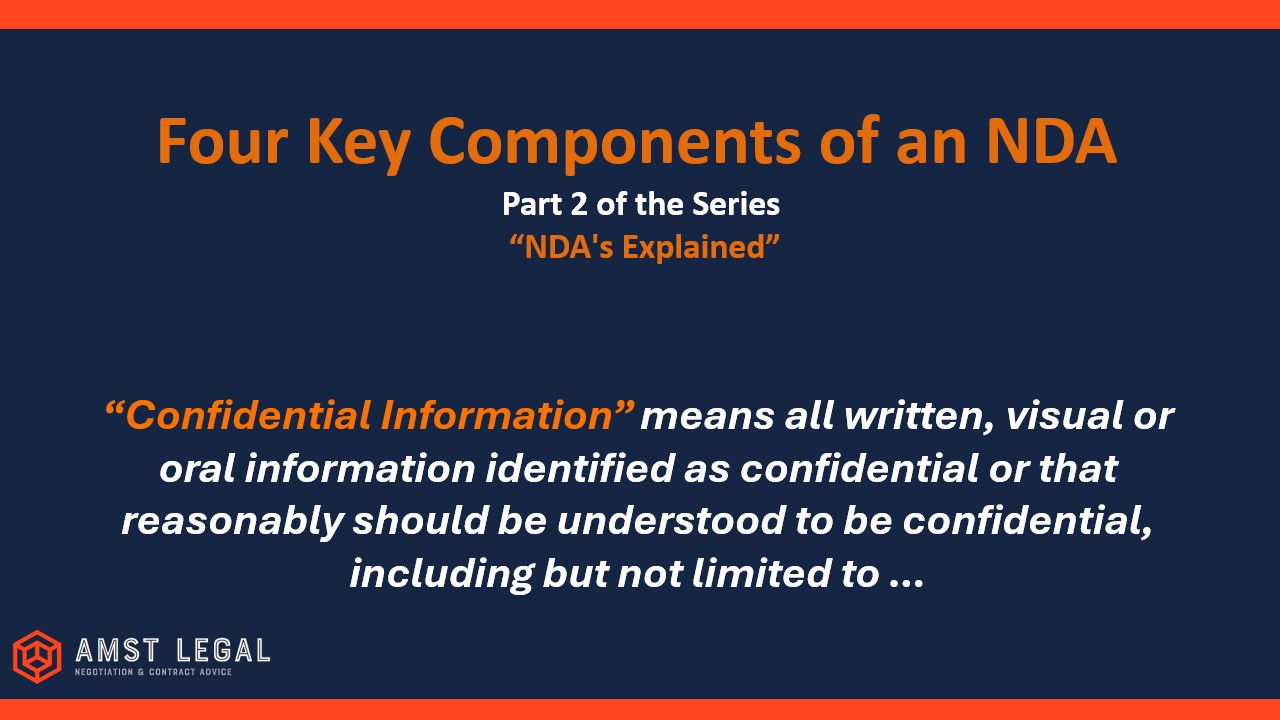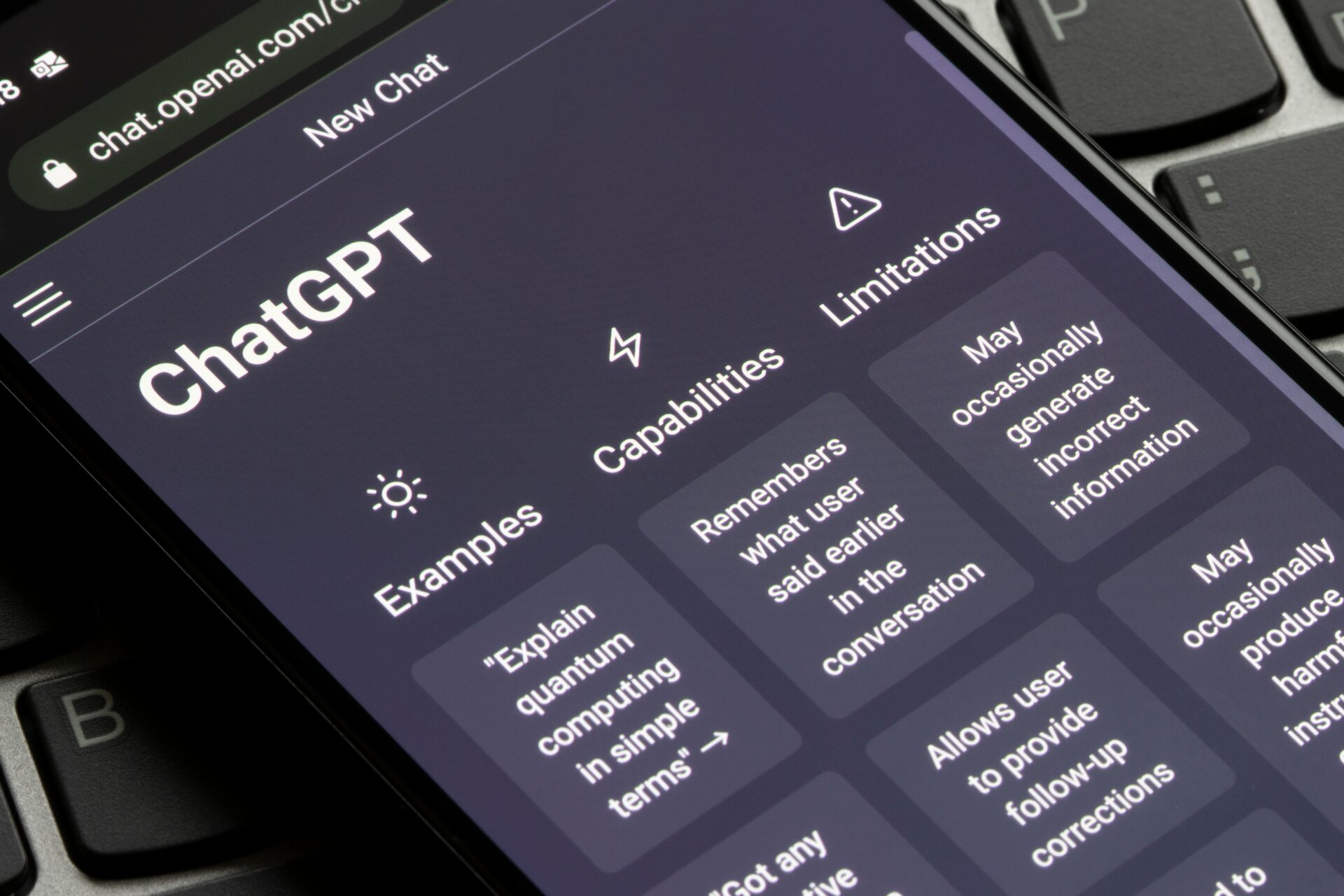
Ultimate Guide how ChatGPT, Perplexity and Claude use Your Data
AI Data use is at an all-time high and data privacy & confidentiality is incredibly important when using AI models. Before you add text or documents to AI Models, read below how and when these platforms might use your content. We also list what content to avoid adding to the models and why AI Policies can be incredibly helpful.
Recently, I had a discussion with a lawyer who shared full client documents, including detailed confidential information, with an AI tool. He was completely unaware that the data we feed into AI systems can be used by the model. That conversation made me realize something important: Not everyone knows how large language models (LLMs) like ChatGPT, Claude and Perplexity actually handle the content we provide.
This is why I wrote this article “Ultimate Guide how ChatGPT, Perplexity and Claude use Your Data”, showing when ChatGPT, Perplexity and Claude uses (or does not use) Your Data.
What we will cover:
- Why businesses, law firms, and other organizations need comprehensive AI policies
- How free and paid versions of ChatGPT differ
- How Claude and Perplexity compare in terms of data handling
- Why you should never share private or proprietary content
The below is an ongoing research project, comparing AI models. Please do not treat the below as legal advice. Always verify current policies to ensure compliance with your (organization’s) requirements – carefully review relevant documentation to understand if and how they might use your input to refine their algorithms.
2. What Are AI Models Learning From? Our Data!
It’s common knowledge that AI models, including ChatGPT, Claude, and Perplexity, are initially trained on large datasets (e.g., internet text, books, articles). However, many people don’t realize that these models can also learn from the additional content we submit. This includes for example when we’re asking them to:
- Analyze or summarize data (e.g., uploading sections of a contract)
- Write or edit an article (e.g., pasting confidential notes)
- Generate ideas or code (e.g., providing business-critical snippets)
Whenever you input text into these systems, it may be used – depending on the model and the plan you’re on – to further refine or train the AI. In this article, we’ll dig deeper into how various well-known models handle (or don’t handle) your content, so you can make more informed decisions when you’re working with sensitive data.
3. ChatGPT: Paid vs. Non-Paid Tiers
ChatGPT is currently the most widely used AI model – focusing on Chatbots / Generative AI. It is important to understand the difference between the paid and free models of OpenAI when focusing on data privacy, confidentiality and to answer the question whether Open AI uses your data to train their model.
ChatGPT (Free)
- Data Usage: Under the free model, OpenAI may use the content you provide to further train or refine the model. This means if you share potentially sensitive information, it could (in theory) be included in the AI’s training data. See the Terms of Use for OpenAI (Free) on this point – I add the relevant part relating to whether it will be able to use your Input in the image below.
- Key Takeaway: Be mindful of what you enter into the model. If it’s something you wouldn’t want to become part of the broader AI model or if it’s private, proprietary or personal, do not include it in your prompts. Also remember that it can be against the law to add certain content.
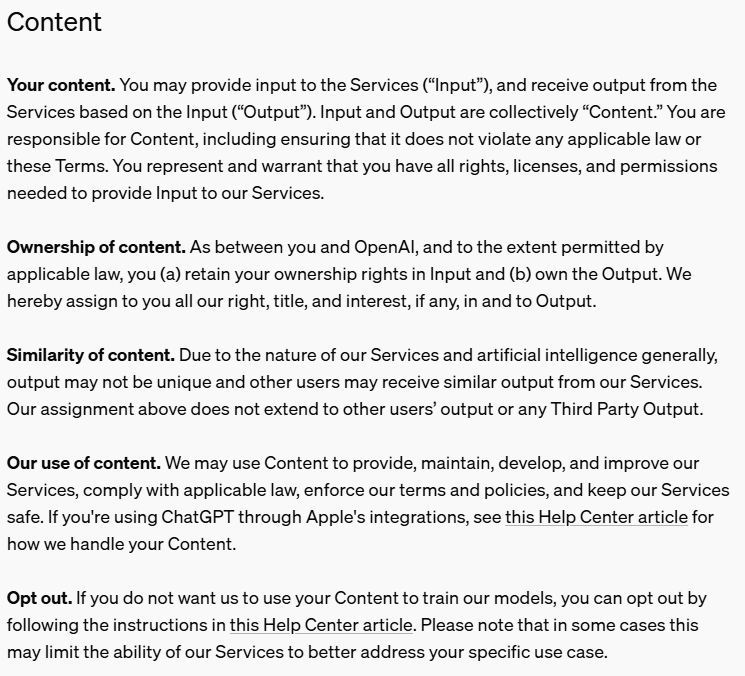
ChatGPT (Paid: Enterprise, API, and Other Business Solutions)
- Greater Privacy: According to OpenAI’s Enterprise Terms of Use, customer content is not used to develop or improve the service. See the Business Terms for OpenAI (Paid) on this point. See image below – I add the relevant part whether it will be able to use your data.
- Stronger Security: Enterprise clients typically get enhanced security measures, better data handling policies, and the option to opt out of data usage altogether.
- Who Should Consider This: Those handling confidential documents, proprietary business processes, or sensitive client data. Lawyers, for instance, might prefer the enterprise offering if they frequently need to process large volumes of privileged information. However, we should note that it is not certain that this Input & Content is secure. Currently, until further notice we would still advice everyone – especially lawyers, doctors, government employees and other that have access to sensitive information not to add such information in the AI models.
- Opt-out: If you do not want your data contributing to AI model improvements, go to the following link to opt-out: https://lnkd.in/dVPcMfH8
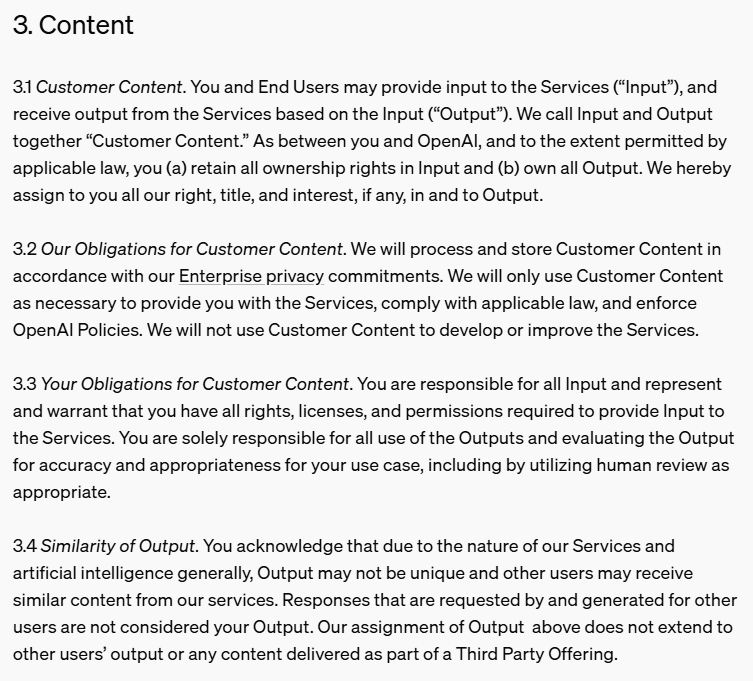
4. Comparing Other AI Models: Claude and Perplexity
Next to ChatGPT there are many other AI models that are used. As we will handle Gemini next time, we will go into the details on Claude and Perplexity in this Article.
Claude (by Anthropic)
- Focus on Safety: Claude is well-known for its emphasis on AI safety and ethical guidelines. However, terms regarding data usage can still allow the model to analyze or store user inputs for system improvement unless otherwise specified. See the Consumer Terms of Service of Claude on this point. See image below – I add the relevant part whether it will be able to use your data.
- Paid Services: Anthropic offers enterprise solutions as well, which comes with a separate set of Commercial Terms containing stricter confidentiality and privacy protections. They have also added the following text in the Commercial Terms of Service: “Anthropic may not train models on Customer Content from paid Services“. Always check the most recent Terms of Service for precise details.
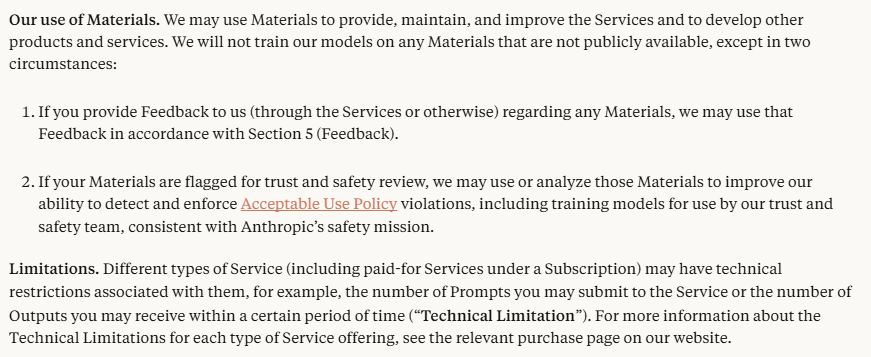
Perplexity
- Research-Oriented: Perplexity is built around providing concise, sourced answers. It has been explained to me as more the “Google” way of searching in AI models. It has been said that Perplexity may not store or use data exactly like ChatGPT. However, the Terms of Service seem to indicate that Perplexity will use your Content – amongst others – for training purposes. See relevant part of Art. 6.4 (b) here: “Accordingly, by using the Service and uploading Your Content, you grant us a license to access, use, host, cache, store, reproduce, transmit, display, publish, distribute, and modify Your Content to operate, improve, promote and provide the Services, including to reproduce, transmit, display, publish and distribute Output based on your Input. “ See image below – I add the relevant part whether it will be able to use your data.
- Enterprise Terms of Service: See these specific terms here. Enterprise customers do provide a license to Perplexity regarding their content. However, the following important wording is added: “Notwithstanding the foregoing, Perplexity does not and will not use Customer Content to train, retrain or improve Perplexity’s foundation models that generate Output.”
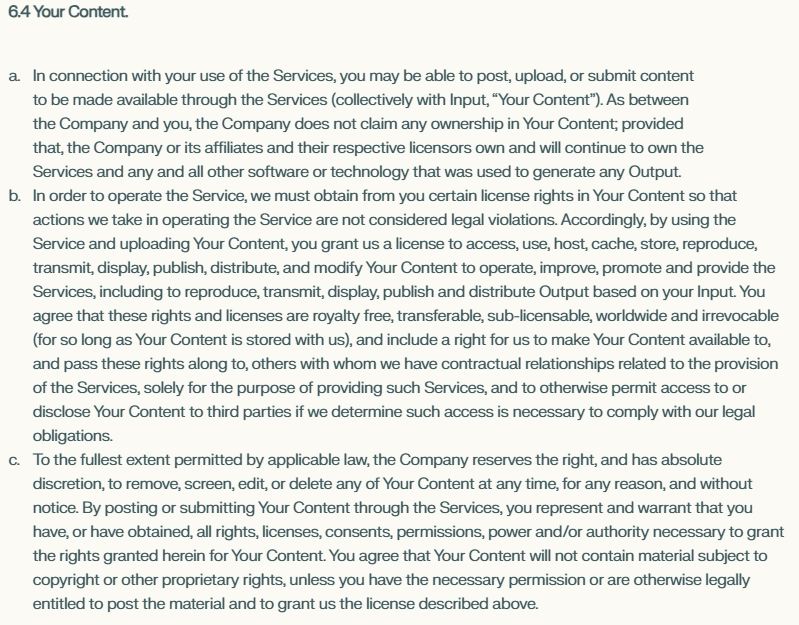
5. What Not to Upload to AI Tools
Whether you’re using ChatGPT, Claude, Perplexity, or any other AI platform, apply common sense and caution. Avoid sharing for example:
- Confidential details (client, business or family member names, private letters, contracts & strategies).
- Personally identifiable information (PII) (addresses, phone numbers, medical records).
- Proprietary or business-critical data (unreleased products, prices, financials).
- Sensitive materials (health info, internal memos, or business & personal).
- Data protected by Applicable Law (copyright, illegal data, government data).
If you must work with potentially sensitive text, consider (a) anonymizing the data first, (b) using an enterprise-level AI solution where the Terms of Use prohibit using your content for model training or (ii) an ‘on-premise’ AI model that anonymizes data.
6. Why Organizations Need AI Policies
Many organizations still lack formal guidelines for using AI tools, leaving employees to guess what’s permissible. It is our understanding – and our worry also – that most employees don’t even realize or understand which data they should or should not add to the AI models. This is why we advocate for the wide use and deployment of AI Policies in companies.
Here’s why AI policies matter:
- Education & Awareness: Ensures everyone in your organization understands the risks and best practices when interacting with AI.
- Risk Management: A solid policy helps prevent data leaks and breaches of confidentiality.
- Compliance: Aligns your company or legal practice with industry regulations and local laws—a must for highly regulated sectors.
- Consistency: Establish uniform standards so that everyone, from interns to senior partners, uses AI responsibly and avoids costly mistakes.
Stay tuned: We’ll be writing a longer article soon detailing the key components of an effective AI policy, with real-world examples to guide your organization’s strategy.
7. Real-World AI Policy Examples
There has been a lot of discussion on whether it should be forbidden to use AI models for work – in some countries it is even forbidden for everyone. I believe that this is the wrong way of dealing with this technology that we will not be able to stop. We should embrace AI technology but be very mindful how to use it. See below two examples of courts and lawyer organizations that believe you should not ban AI, but embrace it with correct guardrails.
Florida Bar’s AI Policy
The Florida Bar issued Ethics Opinion 24-1 on January 19, 2024, providing guidance on the use of generative AI by Florida attorneys (source link: 16).
Key points include (source: 1) :
- Lawyers may use generative AI in their practice, but must:
- Protect client confidentiality
- Provide accurate and competent services
- Avoid improper billing practices
- Comply with lawyer advertising restrictions
- Attorneys must research AI programs’ policies on data retention, data sharing, and self-learning to maintain client confidentiality
- Lawyers are responsible for their work product and must verify that AI use aligns with ethical obligations.
- Informed client consent is recommended when using third-party AI programs that involve disclosure of confidential information.
Delaware Supreme Court’s AI Policy
The Delaware Supreme Court adopted an interim policy on October 21, 2024, governing the use of generative AI by judicial officers and court personnel (see full text here: 7). Key aspects (source: 11) include:
- The policy allows the use of approved generative AI tools by judicial branch officers, employees, law clerks, interns, externs, and volunteers.
- Users of AI remain responsible for the output and must ensure accuracy.
- Training on AI capabilities and limitations is required before use.
- AI should not influence judicial decisions or replace human judgment.
- AI use must comply with existing laws and judicial branch policies.
- Only approved AI tools are permitted on state technology resources.
Both policies aim to balance the benefits of AI in legal practice with ethical considerations and safeguards to protect client interests and maintain the integrity of the legal system. More and more courses are being offered for lawyers & judges explaining the risks and how to avoid them.
The above examples contains external information gathered from Perplexity – mentioning all sources used for the information shared. We have not verified the AI policies or the (latest information relating thereto) in detail at this moment.
8. Embrace AI—Responsibly
From streamlining legal tasks, writing articles to supporting creative brainstorming, generative AI offers enormous advantages. However, that conversation with the lawyer who unknowingly uploaded full client files to a free-tier AI tool reminds us that we to improve our understanding how AI models handle our data.
- Read the Terms: Familiarize yourself with the data usage policies of each AI platform you use.
- Choose Wisely: If data sensitivity is high, consider enterprise solutions or what we at this time advise most legal professionals: do not share sensitive data.
- Use Caution: Always think twice before uploading potentially sensitive content.
- Establish AI Policies: Protect your organization, employees, and clients by setting clear, enforceable guidelines.
Final Thoughts
AI is transforming the way we work – but it’s also transforming how data can move beyond our control. Actively keep track of how your content is used, whether you’re on the free or paid version of ChatGPT, Claude or Perplexity
The lesson? We need to stay informed, be cautious and be proactive. That way, you can use the power of AI without compromising your most sensitive information. Keep an eye out for our upcoming in-depth article on building AI policies that can guide you and your team toward ethical and secure usage of these exciting new technologies.
Disclaimer: This article is a research project, provides general information about AI data usage and does not constitute legal advice.
I wrote this article further to my post on LinkedIn on this subject. If you have any further questions about the above, contact me via lowa@amstlegal.com or set up a meeting directly here .

The Best Way to Efficient Contract Redlining in Negotiations
Lately, there has been a discussions about the best way to redline a contract during negotiations. When redlining a contract, should you simply send an amended redlined Word document and move on? Or should you adopt a more elaborate 6-step plan (including a pdf compare), as highlighted in various legal circles? When we talk about contract redlining, we mean ‘𝘵𝘩𝘦 𝘱𝘳𝘰𝘤𝘦𝘴𝘴 𝘰𝘧 𝘦𝘥𝘪𝘵𝘪𝘯𝘨 𝘢 𝘤𝘰𝘯𝘵𝘳𝘢𝘤𝘵 𝘸𝘩𝘦𝘯 𝘯𝘦𝘨𝘰𝘵𝘪𝘢𝘵𝘪𝘯𝘨’.
In this article ‘The Ultimate Guide to Efficient Contract Redlining in Negotiations’, you will find an in-depth look at how each contract redlining approach works.
I will also explain why we at AMST Legal believe continuing in one evolving redlined document (with occasional compares) is usually the most efficient, transparent and client-friendly method. We will also explore Nada Alnajafi’s (writer of the book Contract Redlining Etiquette) 10-step process so you can see precisely how an experienced contracts professional handles redlining from start to finish.
1. What We Will Cover
- Why the Debate? The origins of the 6-step approach vs. a single redlined doc
- Key Principles: Efficiency, transparency, and clarity for all parties
- When (and How) to Use Compares: Ensuring every edit is captured accurately
- When (and Why) to Avoid Extra PDFs: Why separate PDFs often add clutter
- Nada Alnajafi’s 10 Steps (Quoted in Full): A data-backed method for efficient redlining
- Final Takeaways: The balanced approach that works for most teams
2. Understanding the Debate
The Six-Step Approach vs. a Single Redline Document
As mentioned in my post on Linkedin on this subject, we noticed that in some legal circles, lawyers have embraced a 6-step process to handle contract edits. After they receive the new draft from the counterparty, they take the following steps:
- Accept all changes in the document you receive from the counterparty you are negotiating with (your new “clean” version).
- Compare old vs. this new draft to ensure that all changes compared to the previous version are visible.
- Amend the new “clean” version (can be amended by one or multiple people in the same organization).
- When finalized with adding comments & amendments, Compare again to show new changes to counterparty and to make the final check.
- Save the fresh comparison as a PDF.
- Send both the new “clean” doc (as amended) + the compare PDF.
For the avoidance of doubt, at AMST Legal we do not recommend this approach, except where agreed or desired by your client, customer or counterparty.
Advocates of this 6 step approach argue it helps manage large, complex deals – especially when multiple stakeholders are involved – by producing a neat record of only the latest changes.
Critics see it as time-consuming overkill that can inflate billable hours, make negotiations overly complicated and confuse counterparties who want to see comments and explanations in one place.
We have found that most:
- Critics are legal professionals involved in negotiating commercial contracts like NDA’s, MSA’s, sales, procurement and partner agreements.
- Advocates are lawyers in Big Law (large law firms) that are involved in finance and corporate transactions.
In general, most legal professionals seem to prefer to stick with one progressive redlined document, continuously layering edits and resolving comments as issues are settled. This single-document approach is often more efficient for commercial & smaller deals or simpler contracts, and it preserves the full negotiation trail.
Origins of the 6-Step Approach
The more traditional “clean + PDF compare” method likely emerged when Microsoft Word’s Track Changes was buggy or unreliable in large documents. Many practitioners still worry about hidden edits or formatting issues – concerns that, at one time, were quite valid. Others claim that by resetting to a “clean” version each time, you reduce the clutter of multiple layers of color-coded changes and make it simpler for executives to see only newly introduced edits.
However, Word has significantly improved in comparing documents and most commercial legal professionals do not believe that separate software like Litera and Deltaview) is still necessary. Additionally, best practices between legal professionals have been developed and are widely in use that mitigate most of these issues. That’s why many in-house counsel and lean legal teams opt to remain in a single track-changed doc for efficiency.
3. Key Principles of Effective Contract Redlining
Efficiency
As also advocated by Nada Alnajafi here, in a commercial setting, it’s typically best to redline a single version of the contract. Next to adding explanatory comments, you accept or reject changes as you reach agreement, and layer any new edits into the same tracked document.
This approach:
- Reduces confusion by keeping one “source of truth.”
- Retains comments in context, showing how and why each change evolved.
- Saves time for your counterparties, who don’t have to juggle multiple files.
Transparency
Continuous redlining gives all parties a full view of the agreement’s evolution. Rather than delivering a “clean” Word doc that erases prior edits, you preserve the document’s story. This makes it easier for anyone (clients, internal teams, or external counsel) to see what has changed over time. Inline or ‘balloon’ (our preferred method) comments further ensure each party can understand the rationale behind edits.
Clarity
One of the top goals in contract negotiations should be clarity. When you present the counterparty (or internal stakeholders) with a single redlined version:
- They immediately identify recent changes.
- They can refer back to older, accepted edits if needed.
- They see important comments and open questions without having to hunt through separate documents.
- You can ask your internal stakeholders specific questions, which they can resolve in the same document.
4. When (and How) to Use Compares
Validate Your Changes Internally
Even if you prefer to continue in the same redlined doc, a document compare can still be incredibly valuable for quality control – especially in multi-stakeholder negotiations. What happens often in negotiations is that two lawyers lead the negotiation, but they ask input from various specialists like experts in data privacy, tax, data security, product, intellectual property etc.
Before circulating a “new” version externally, run a compare on your own to ensure you haven’t accidentally skipped anything or misapplied a request from the other side. This step helps catch:
- Missed revisions or hidden text changes.
- Accidental deletions or additions that no one noticed.
- Formatting or numbering issues that might cause confusion later.
Provide a Compare Alongside the Redline in Complex Deals
In more complicated deals where multiple stakeholders (e.g., finance, technical, local counsel in different jurisdictions) are editing the same draft:
- Stick to One Master Redline – Everyone tracks changes in the central Word document.
- Create a Compare Version (at Key Milestones) – If your CFO, the counterpart or external counsel only wants to see what’s new since the last milestone, you can provide a compare word file or PDF (as a matter of exception) in addition to the main redline.
Tip: Communicate why you take this extra step.
5. When (and Why) to Use or Avoid Extra PDFs
At first glance, PDF redlines can seem like old-school overkill. Why not stick to Word track changes? But in certain cases, like when working with large law firms or complex finance and corporate deals, PDFs are not only accepted but often expected.
Let’s dive into the “mobile-viewing” and “Locked Compare Can’t Be Accidentally Edited” rationale driving PDFs.
The Mobile-Viewing Argument
Some lawyers say they send PDFs because executives often review contracts on smartphones – and a PDF might be easier to read on mobile. While there’s some truth to that, it usually doesn’t justify an entire multi-step PDF approach for each iteration. Instead:
- Ask your client or opposing counsel if they truly need a PDF on every turn.
- If necessary, just export your tracked Word doc to PDF, maintaining comments and highlights.
A Locked Compare Can’t Be Accidentally Edited
Another reason some teams stick to PDFs is that a PDF compare can’t be inadvertently altered, unlike a Word-based compare that might be changed by mistake. To be honest, I have seen this happen more than once in a large negotiation with many parties involved.
This “locked” snapshot can be reassuring for large finance or corporate transactions—especially when multiple parties are scrutinizing each version. However, even this benefit doesn’t mean you need a separate PDF for every round of edits.
In most commercial negotiations, a single redlined Word doc plus occasional internal compares is enough. Extra PDF compares can be saved for big milestones or final checks.
Potential Downsides of Separate PDFs
- Loss of Comments: Often, inline comments are not as interactive in PDFs. They do not work as well as comments in Word.
- Extra Steps: You spend more time saving, comparing, and formatting multiple files.
- Reduced Collaboration: PDFs limit the recipient’s ability to directly edit or reply in real time.
- Confusion: especially business people (sales, executives, etc.) might be confused why separate documents are sent and questions arise which document to review or amend.
6. How Legal Tech and AI Can Simplify Redlining
A straightforward way to tackle many redlining headaches is to turn to Legal Tech – particularly Contract Lifecycle Management (CLM) platforms and AI-powered solutions. See this article from Krysta Johnson on this subject for example. Below is a quick look at how these tools can streamline your negotiation process:
Key Benefits of Modern Legal Tech
- Centralized Dashboard
Keep contracts, edits, and comments in one place. No more searching for scattered files or wondering which version is current. - Automated Workflows
Easily ping the right teammates or approvers when it’s their turn. Once they’re done, their feedback is automatically saved and organized, cutting down on email clutter. - Smart Document Comparison
AI can quickly scan and highlight every edit between drafts, minimizing the risk of missing hidden changes or problematic clauses. This frees you to focus on actual deal issues rather than manual proofreading.
Bottom Line: By integrating CLM and AI into your redlining workflow, you’ll reduce manual effort, eliminate confusion, and speed up contract negotiations. This brings the team together to focus on what truly matters: reaching a solid, mutually beneficial agreement.
7. Nada Alnajafi’s 10 Steps for Transparent, Efficient Redlining
To illustrate how a seasoned contracts professional redlines documents in a way that promotes transparency, efficiency, and collaboration, Nada Alnajafi (Founder of Contract Nerds and author of Contract Redlining Etiquette ) has identified 10 key steps in this LinkedIn post. She emphasizes that this framework is backed by real data from thousands of contract professionals, not just personal preference:
Key Points
- Start in Word: Open the counterparty’s redlines in Microsoft Word to keep everything in one editable format.
- Get the Big Picture: Skim the draft from start to finish for an overview of the level of disagreement and the other side’s negotiation style.
- Dive Deeper: Review the document thoroughly to identify areas needing attention, extra discussion, or stakeholder input.
- Accept & Resolve: Accept any edits you agree with and resolve closed comment threads to keep the document uncluttered.
- Reject & Propose: For edits you disagree with, reject the changes, propose new language, and add comments explaining your stance.
- Ask Questions: Seek clarification for any unclear edits—better to ask now than to assume incorrectly.
- Consult Stakeholders: For business or commercial changes, loop in your internal teams or relevant departments.
- Summarize Top Issues: When sending your redlines back, highlight the most critical (no more than three) items in a short cover email.
- Request a Call if Needed: If major disagreements persist or time is short, a quick conversation can resolve more than endless markup rounds.
- Verify Before Signing: Run a single doc compare of the original draft vs. the final draft to confirm no hidden changes. Doing it more than once often adds unnecessary friction—especially in an in-house environment.
Nada’s final reminder is that one thorough compare is usually enough. If you repeatedly scrub redlines or generate “clean” versions out of fear or distrust, you risk delaying the process and frustrating everyone involved. For more contract redlining efficiency tips, be sure to check out her book Contract Redlining Etiquette and follow her on LinkedIn.
8. Final Takeaways
The Balanced Approach
- Keep a Single Redline: Work in one main track-changed document, accepting or rejecting changes as deals progress.
- Add Comments: Use inline comments to clarify reasoning or ask questions; this preserves context.
- Run Your Own Compare: Internally verify major new versions against the prior version before sending.
- Consider Sending a Compare: For complicated multi-stakeholder deals, provide a separate compare doc at key milestones, but don’t make it your default for every tweak.
- Avoid Unnecessary PDFs: Unless it’s truly required or requested, do not to use the PDF-based workflow.
- Use Legal Tech & AI: If you’re dealing with many contracts or looking to scale your process, consider specialized tools that streamline workflows.
- Meet in Person: For overly complex or stalled negotiations, a face-to-face (or online) meeting often resolves issues faster than endless redlining.
Why It Matters
- Client-Focused: Clients want clarity, results, and efficiency. They do not want to pay for avoidable drafting detours.
- Reduces Errors: A single doc plus strategic compares minimizes the risk of losing track of changes.
- Saves Time: Keeping everyone focused on one version speeds up reviews and shortens negotiation cycles.
Next Steps
- We advise to move away from the complicated 6-step approach and adopt a single, continuously updated redline with occasional compares.
- For more complex deals, use a hybrid approach: keep a master redline, but generate compare outputs at critical moments in the negotiation.
- Invest in training: Ensure your team is comfortable with Word’s Track Changes, Comments, and Compare features so that everyone contributes to a smooth, transparent workflow.
9. Ready to Streamline Your Redlining?
Contract negotiation doesn’t have to be a complicated (e.g. by using multiple PDFs and “clean” Word files). By adopting a continuous redline strategy—with optional compares as needed—and communicating expectations from the start, you’ll improve transparency, reduce costly errors and keep your clients or business stakeholders happy. Whether it’s an NDA, SaaS agreement or a complex M&A transaction, focusing on one document as your “source of truth” can make all the difference.
Need help? Contact me at rreggers@amstlegal.com or read our blogs for more about efficient negotiation tactics, ways to speed up contract processes and specific contract advice (e.g. relating to NDAs and SaaS contracts). We will work with you to develop a faster, more reliable approach that benefits everyone involved in the deal – based on our 20+ years of experience, aligned with industry-proven methods.

Unlock Contract Efficiency with a Simple Audit of Your Templates
Introduction
Companies often wonder why they should regularly audit their contract templates. This practice, which we implement regularly, often reveals a goldmine of opportunities for streamlining and improving efficiency of contract flows.
When a client approached us to improve its template customer contract, our first step was to conduct a thorough audit of all the contract templates in use. For instance, in one case, we were able to merge 12 separate templates into a single, standardized template applicable across all countries. In other cases, we’ve found multiple templates for different products or specific templates for government-funded versus non-subsidized projects. These findings underscore a crucial step: before improving your templates, it’s essential to first inventory what templates are in use. Only then can you effectively create or refine your templates for maximum efficiency.
1. The Necessity of Regular Contract Template Audits
Contract templates form the foundation of your business agreements, defining the terms and conditions of your relationships with customers, vendors, and partners. Over time, without regular oversight, these templates will (i) be amended in the organisation – often new templates emerge – without knowledge of management and Legal and (ii) be incomplete due to change in laws and products sold, leading to inconsistencies and legal vulnerabilities. A regular audit helps you:
- Risk mitigation and compliance updates
- Maintaining legal efficiency
- Identifying and eliminating redundancies
- Ensuring consistency across all agreements
- Enhancing negotiation speed and effectiveness
- Reducing legal disputes and misunderstandings
- Standardizing terms and conditions
- Keeping templates up-to-date with current laws and regulations
- Uncovering unauthorized or outdated templates
- Improving overall business relationships through clear and fair agreements
2. Steps to Conduct an Effective Contract Template Inventory
a. Gather Information from All Departments
Your legal department might not be aware of every template in use. Engage with various business units—such as Sales, Partnerships, Procurement, and HR—to gather a comprehensive list. Ask them to provide the exact templates they use daily to ensure accuracy.
b. Categorize Templates
Once collected, categorize the templates by:
- Type of Agreement: Customer, vendor, or partner agreements.
- Product/Service: Specific templates for different offerings.
- Geography: Templates used in different countries or regions.
- Language: Versions in different languages.
- Department: Templates specific to various business units.
- Special Conditions: Templates for specific situations, like government-funded projects versus non-subsidized ones.
c. Evaluate and Standardize
Review each template to identify discrepancies and outdated clauses. Standardize the language and format to ensure consistency across all agreements. This process not only reduces errors but also improves the clarity and enforceability of your contracts.
3. Addressing Common Issues in Customer, Vendor, and Partner Agreements
a. Customer Agreements
- Scope of Services: Ensure a clear description of the services or products provided.
- Payment Terms: Standardize payment schedules and terms.
- Liability Clauses: Update liability and warranty clauses to reflect current business practices and legal standards.
b. Vendor/Procurement Contracts
- Quality and Delivery Terms: Standardize terms related to quality control and delivery schedules.
- Compliance: Ensure all vendor contracts comply with relevant laws and regulations.
- Payment Terms: Regularize payment structures and terms to avoid discrepancies.
c. Partner Agreements
- Roles and Responsibilities: Clearly define the roles and responsibilities of each party.
- Profit Sharing: Standardize profit-sharing mechanisms.
- Exit Strategies: Include clear exit strategies to handle potential dissolution scenarios.
4. Uncovering Unauthorized Templates
During your audit, it’s not uncommon to discover templates in use that the legal or management teams were unaware of. These unauthorized templates, often created without prior approval, can pose significant risks. Identifying and rectifying these situations is crucial to maintaining legal and operational integrity. Ensure that all templates are vetted and approved to align with your company’s standards and legal requirements.
5. Benefits of a Well-Organized Contract Template Inventory
Maintaining an organized inventory of your contract templates offers several benefits:
- Improved Negotiation Speed: With standardized templates, negotiations become quicker and more efficient.
- Reduced Legal Risks: Consistent templates minimize the risk of legal disputes.
- Enhanced Business Relationships: Clear and fair agreements foster stronger business relationships.
Conclusion
Regularly auditing and organizing your contract templates is a crucial step in enhancing your business’s legal efficiency. By taking the time to inventory, evaluate, and standardize your agreements, you can streamline your processes, reduce risks, and build stronger, more transparent business relationships.
For more detailed insights and personalized advice, feel free to contact us or schedule a consultation.

How to Improve Your Negotiation – 7 Best Books to Read
7 Great Books to start with when you want to improve your Negotiation style. You will absolutely see that you will be a better negotiator if you apply the lessons mentioned in these books.

Förklaring av NDAs – Vad du behöver veta (del 1)
Förklaring av NDAs – Vad du behöver veta (del 1)
I den konkurrenskraftiga affärsvärlden där idéer, innovationer, finansiell information och hemligheter är framgångsnycklarna, spelar Non-Disclosure Agreements (NDAs) ofta en viktig roll i att skydda ett företags konfidentiella information. NDA säkerställer att den konfidentiella informationen endast används för det specificerade ändamålet som parterna i en affärsrelation avtalat om. Denna artikel kommer att ge en omfattande översikt av NDA i sammanhanget Business to Business (B2B).
Vad är ett NDA?
Ett NDA, även kallat sekretessavtal, är ett juridiskt bindande avtal mellan två eller flera parter med syfte att skydda konfidentiell information som kan komma att delas under tiden av deras affärsrelation. Mer specifikt är företags konfidentiella information icke-offentlig information som skulle kunna skada företaget om det skulle offentliggöras. Vanligtvis inkluderas en lista över den konfidentiella informationen i avtalet. Det kan innehålla exempelvis affärshemligheter, know-how, produkt- och teknikrelaterad information, rabatter, kundlistor, försäljnings- och finansiell information, affärsplaner etc.
Varför och när behöver vi ett NDA?
I B2B-sammanhang kan NDA vara ett väsentligt verktyg för att skydda affärshemligheter och annan konfidentiell information som är viktig för ett företag för att bibehålla dess konkurrensfördelar. Denna känsliga information bör därför definieras tydligt och noggrant i NDA. Var däremot försiktig med att inte definiera det för snävt för att säkerställa att du inte har missat en viktig kategori. Genom användande av ett korrekt utformat NDA kan ditt företag skydda värdefull information från konkurrenter eller tredjeparter som kan dra nytta av att sådan information avslöjas.
Primärt syfte
Det primära syftet med ett NDA är att säkerställa att den avslöjade känsliga informationen används och hanteras säkert, vilket förhindrar en avslöjande part att använda eller röja informationen utan vederbörligt tillstånd och behörighet. Ett NDA undertecknas ofta i början av en affärsrelation innan man går in i affärsrelationen.
Exempel
Vanligt exempel: Ett teknikföretag planerar att sälja och erbjuda specialiserade programvarulösningar till en företagskund. Företagen börjar med att diskutera hur man integrerar programvaran i kundens system för att fastställa priset för integrationen och användningen av programvaran. För detta kan teknikföretaget dela insyn om sin prissättning, SLA, policys och programvara, och kunden kan i sin tur förklara sina utmaningar och dela affärsplaner. När företagen gör detta planerar de således att dela dokument, inklusive icke-offentliga sådana, det vill säga konfidentiell information. Därför rekommenderas det att sådana företag skriver under ett NDA innan de delar sådan konfidentiell information sinsemellan. Ett sådant NDA kan sägas upp när parterna undertecknar ett slutligt kundavtal, vilket också bör inkludera sekretessvillkor.
Hur skyddar ett NDA din konfidentiella information?
Precis som för vilket annat juridiskt avtal som helst, medför avtalsbrott av ett NDA rättsliga konsekvenser. Beroende på avtalsbrottets allvar kan konsekvenserna sträcka sig från rättsprocesser och ekonomiska påföljder till åtal i extremfall. Avtalsbrott avseende ett NDA kan också skada en parts renommé, vilket kan leda till andra långvariga konsekvenser för dess affärsverksamhet, särskilt i affärsrelationer och i branscher där förtroende och sekretess är avgörande. Rättsliga anspråk och stämningar rörande avtalsbrott av ett NDA hör inte till vanligheten, men det händer definitivt att ett företag behöver betala vite för avtalsbrott. Vi har även gett rådgivning några gånger tidigare i denna fråga.
Vilken slags NDA behöver du?
Det finns olika typer av NDA som kan användas baserat på de specifika omständigheterna och de involverade parternas behov. Nedan listas de tre vanligaste typerna:
- Unilateralt NDA (Ensidigt NDA): I ett ensidigt NDA ålägger en part, vanligtvis säljaren, den andra parten skyldigheten att säkra informationen och inte avslöja eller använda informationen för något annat syfte än det som specificerats i avtalet. I ett B2B-sammanhang, används ensidiga NDA ofta mellan köpare och säljare. Exempelvis kan ett bioteknikföretag (säljare) använda ett ensidigt NDA för att förhindra köparen från att avslöja känslig information de har fått vid köp av produkter eller tjänster såsom immateriella rättigheter och datorteknologi. Det är även vanligt i offentliga upphandlingar och för RFI (Request for information) vid RFP (Request for Price) situationer.
- Gemensamt NDA (tvåsidigt eller ömsesidigt NDA): Ett ömsesidigt NDA involverar två parter där båda parter kommer att dela känslig information med varandra och kommer ömsesidigt överens om att båda parter blir bundna av tystnadsplikt. Ömsesidiga NDA används ofta när parter behöver utbyta betydande mängder av konfidentiell information under sina förhandlingar eller affärsrelationer. Sådana situationer kan vara joint ventures, leverantörsavtal eller företagsförvärv.
- Multilateralt NDA (tre- eller flerparts NDA): Ett multilateralt NDA inkluderar tre eller fler parter, där åtminstone en part delar känslig information med andra parter och genomdriver tystnadsplikt. Den här typen av NDA förenklar pappersarbetet och administrationen för parterna på så sätt att parterna inte behöver ingå flertalet ensidiga eller bilaterala NDA med varandra. I en affärsrelation som involverar tre parter, där alla förväntar sig att avslöja konfidentiell information, kan ett enda multilateralt NDA ersätta behovet av tre olika bilaterala NDA mellan varje partspar. Sådana situationer kan vara partnerskap, regeringskontrakt (såsom försvars- och rymdfartskontrakt) och konsortieavtal.

Contract Management: Two Simple Tips to Optimize Your Contract Templates
Introduction: Understanding Contract Optimization
In today’s business environment, efficiency and clarity in contract management are more crucial than ever. One question we frequently encounter is, “What exactly is Contract Optimization Advice?” This concept might seem intricate at first glance, but it’s fundamentally about streamlining your contract processes to save time, reduce errors, and ensure legal compliance. Let me illustrate this with a straightforward example from our recent advisory work.
The Challenge: Streamlining Contract Processes for Enhanced Efficiency
A client approached us with a common yet complex challenge. They had two separate (fairly long) customer contracts in use, signed approximately 100 times each year. These contracts were:
- A standard customer contract for clients not receiving subsidies or government funding.
- A standard customer contract for clients that do receive such financial support.
They asked us to improve the wording of the contract, ensuring that companies signing the contracts understood the contracts sufficiently, avoiding legal jargon where possible. Additionally, they asked to advise them how to amend the contract in such a way that processes would be more efficient. Most importantly, we would of course focus on lowering the risks for the company, where reasonably possible.
Both contracts included a pricing annex, which was subject to regular updates.
Our Approach: Simplification and Innovation
After a brief introductory call with the client and a review of the contracts, we proposed a straightforward yet innovative solution. Our advice focused on two initial key changes which we already proposed without going into the details of the full contracts.
- Consolidation into One Contract: We recommended merging the two contracts into a single document with a distinct annex for subsidy or funding conditions. This approach not only simplifies the contract management process but also ensures that all customers are subject to the same core terms and conditions, promoting fairness and transparency.
- Digital Pricing Updates: To address the challenge of the frequently updated pricing annex, we suggested adding a link to the pricing information on the company’s website. This allows for real-time updates to be made accessible immediately after notifying customers, thereby significantly reducing administrative burdens and enhancing operational efficiency.
The Impact: A Smoother Path to Business Success
Our client implemented these changes and observed a noticeable improvement in their contract negotiation times and overall legal process efficiency. More importantly, this optimization made their business operations smoother and their customers happier by providing clearer, more accessible contract terms.
Conclusion: Let Us Simplify Your Contractual Challenges
Contract optimization is more than a service; it’s a pathway to enhancing your business’s operational efficiency and customer satisfaction. By embracing simplicity and leveraging technology, we can help you navigate the complexities of contract management with ease.
Are you ready to streamline your contract processes and make your business life easier? Contact us for tailored contract optimization advice. Book an appointment with us to discuss possibilities for your company.
Tags: #AMSTLegal #ImproveYourContracts #ImproveYourTemplates #Negotiation #ContractLaw #LegalEfficiency #Legal #CommercialContracts

How to improve your Contract Processes with Better Cooperation
Legal should focus on Better Cross-Departmental Cooperation
As we have highlighted in previous posts, it takes leadership and a team to improve your contract templates. Once Legal has taken the lead and the centralized responsibility to improve the contract templates, the next step is to involve and work together on this goal with other departments. The creation and use alone of contract templates will only offer limited benefits This is not only essential to receive all required input for the contract templates, but also for a successful implementation of the contract templates.
Legal professionals often limit their interactions to their Legal colleagues or senior management when creating and implementing contract templates or negotiating contracts. This limitation, while understandable, can lead to contract templates and agreed contracts that are legally sound but are missing critical business insights.
Additionally, as mentioned above, the complexity, inaccuracy and lack of processes will lead to the use of unauthorized or outdated templates and excessive Legal Review due to lack of internal processes and support from other departments.
Insight Integration: A Collective Approach on Template Creation
Therefore, aligning contract templates with the practical realities of the business is essential. Departments such as Sales, Products, Finance and Compliance offer invaluable insights on commercial and financial risks, practical considerations and the specificities of products or services offered by the company.
This input ensures that the contract templates are not only legally robust, but also fit in the commercial roadmap of the company and cover all other company risks (e.g. technical, compliance, operational and financial).
Another important reason to involve these departments in the drafting process of the templates is to create a sense of ownership and support from these stakeholders. When departments contribute in the development of the standardized contract templates of a company, they are more likely to endorse and actually use the templates. This collaborative approach not only enhances the quality and relevance of the contract templates but also ensures their acceptance and utilization across the organization, ultimately leading to smoother operations and reduced risks.
Enhancing Cross-Departmental Collaboration – Improve Communication & Cooperation
Legal´s role in improving the communication and cooperation with the rest of the company cannot be understated. Regular, strategic meetings between Legal and other departments are essential to set the stage for a more integrated and efficient approach to contract management of the company.
These discussions should focus on:
- a) Strategic Alignment: First, Legal needs to clearly communicate its short and long term intended contract optimization strategy to all departments. Secondly, these departments should share their strategy and specific requirements and contributions to the contract process and templates. This will give Legal the opportunity to create and roll-out the best strategy to improve the Company´s contract processes and templates.
- b) Issue Identification and Resolution: Facilitating an open dialogue where Legal and all other departments can highlight challenges encountered with current templates and collaboratively develop solutions to streamline cooperation and reduce operational burdens.
- c) Training and Involvement: Initiating internal workshops to educate teams on optimal contract template usage, Legal engagement policies, while encouraging feedback and suggestions for improvements to ensure templates remain relevant and effective.
- d) Proactive Communication: Discussing the optimization of the empowerment of the commercial teams, meaning that all relevant contract-related documents and information are proactively shared with customers and partners by the Sales, Partnerships and Procurement teams.
This will greatly minimize the workload of Legal and maximize their output due to a decreased need of Legal clarifications and Legal involvement in negotiations. The importance of regular, inclusive meetings and training sessions cannot be overstated. When planning, it is essential to engage every layer of the organization, from grassroots employees to top management, in strategic discussions and trainings.
These sessions serve as a cornerstone for aligning strategies, creating an environment where all team members are equipped with the knowledge and skills to navigate the complexities of the contract optimization process and their roles effectively.
By maintaining a consistent schedule of these critical discussions and training, organizations can avoid the pitfalls of reactionary measures during peak periods of activity. Instead, a well-informed and strategically aligned team will be ready to handle the demands of the business efficiently, ensuring continuity and resilience in the face of challenges.

Contract Negotiations: How to Avoid Negative Reactions in Redlines and Mark-ups
𝗤𝘂𝗶𝗰𝗸 𝗖𝗼𝗻𝘁𝗿𝗮𝗰𝘁 𝗡𝗲𝗴𝗼𝘁𝗶𝗮𝘁𝗶𝗼𝗻 𝗧𝗶𝗽 𝗼𝗳 𝘁𝗵𝗲 𝗗𝗮𝘆: When reacting to a comment or suggested wording by a counterparty that is commenting on your contract, 𝘢𝘷𝘰𝘪𝘥 using negative language like:
“Adding this wording in the Article is incorrect because it has already been covered in Art. 12.”
Instead, try saying:
“Thank you for your comment. I agree with your addition. Please note that we have already covered this in Art. 12.”
Additionally, for important subjects, you can add:
“If you do not agree with this wording, please let me know”; and/or
“Please let me know if you would like to discuss this topic during our next meeting”.
As we know, during contract negotiations, it’s important to maintain a cooperative relationship with the other party. Remember, the counterparty is also just doing their job and you are working together to reach a mutually advantageous outcome.
By using positive language in your reactions to comments, you can help keep negotiations running smoothly and maintain a good relationship with the counterparty.
For a bit more background on The Importance of a Relationship in Negotiations, please see the following article on the Harvard website.
See our original post on this subject on LinkedIn
#ContractNegotiations #HowtoNegotiateBetter #ContractLaw #AMSTLegal #contracts #negotiation #negotiationskills #relationshipbuilding

Legal in the Lead when improving Contract Templates
To improve your contracts, it is no surprise that we recommend Legal to take the lead in creating and implementing contract templates, particularly for critical documents such as loan agreements, general terms & conditions, DPAs (data processing agreements), etc.
Depending on the maturity of an organisation, leadership and commercial teams often overlook the necessity of Legal approval, which leads to inefficiencies and the risks mentioned in the previous articles on this subject. Even though it might be perceived as slowing down processes, it is advised to let Legal take the lead when creating, amending and rolling out your company´s contract templates.
To illustrate this, see two scenario´s that we encounter in practice:
a) Small Businesses and Start-ups: founders or commercial teams in smaller enterprises rely on freely available online templates or self-made documents. While this is an understandable practical approach in the early stages of a company, it is vital to re-evaluate these initial templates in consultation with Legal.
b) Corporates: even in larger organisations with state of the art templates, it is not unusual that commercial and operational teams use their own, unapproved versions tailored for specific products or services. Case study: For example, when advising a company with 120 employees, we encountered 40 different contract templates of the same Sales Contract – one for each product! As the company – understandably – had serious contract efficiency issues, we worked on successfully consolidating this into three contract templates.
Contracting is a highly cross-functional activity (or at least it should be).2 Legal leadership is nothing without involvement from the other departments in a company. How to do this, we will explain in the next tip in the series how to improve your contract templates.
Doesn´t Legal slow down processes?
There is still a common perception that Legal will slow down processes, which is not correct if Legal embraces the possibilities of (i) standardizing and simplifying the contract templates, (ii) working towards the 80/20 Template Ratio and (ii) contract automation. The research on this subject also confirms that – as we have also experienced in practice in many different companies – that it will actually speed up your processes. Lastly, this is also substantiated by the interest in Legal Tech & CLM (Contract Lifecycle Management) tools offered that automate and streamline contract processes during key stages in the contract lifecycle.
To improve contract templates, more work will indeed need to be done at the start of the process to ensure that the standards not only contain legal, but also business requirements. Once the contract templates have been created and includes the input from all teams (see next tip 4), the standardized templates can be used without input from Legal – which will greatly improve the efficiency, scalability and negotiation time for your contracts.
Automation and Empowerment Commercial Team
Once these contract templates are final, these templates can be made available internally and/or externally depending on the type of contract, for example:
online (Terms and Conditions, DPA, SLA (Service Level Agreement)
contract management software (e.g. Customer Agreement, NDA (Non-Disclosure Agreement), Order Forms; and/or
by the commercial teams (Enterprise Customer Contract, Partner Agreements, Master Services Agreement).
It is therefore crucial to have a central repository and/or automate the access to the contract templates to empower the commercial teams to use the contract templates within the agreed framework. Commercial teams need to be enabled to complete and send out contracts (e.g. Enterprise Customer Contracts, NDAs and Partner Agreements) that are made using the template contracts. More on this in point 5 below.
Broadened Scope
Key to this approach is that Legal is not only involved in leading the effort in creating typical contract templates like NDAs, sales or partnerships agreements, but also documents such as Service Level Agreements, Offer Documents and Order Forms. Once these agreements have been agreed by Legal and the rest of the company, they can be used at scale within the agreed framework.
The Role of Legal
Legal should oversee the drafting, implementation and management of these contract templates to ensure accurate and compliant use of the templates across the organization. Once Legal is in the lead of the contract templates and the business is working according to the 80/20 Contract Template – unsurprisingly – it typically first leads to more work for Legal. This is caused by the fact that Legal now has control over all contracts that are sent out by the company. This is why automation and empowerment of other teams is so crucial.
This brings us to the next points that Legal should focus on: (i) involving other departments in the company and (ii) improving the communication and cooperation with other departments, which we will discuss in our next post

